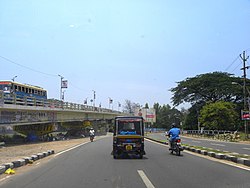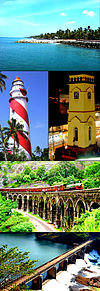Kollam Cantonment | |
|---|---|
Neighbourhood | |
 Model road and Railway overbridge in Kollam Cantonment | |
| Coordinates: 8°52′52″N76°35′57″E / 8.881160°N 76.599078°E | |
| Country | |
| State | Kerala |
| City | Kollam |
| Time zone | UTC+5.30 (IST) |
| Area code | 0474 |
| Lok Sabha constituency | Kollam |
| Civic agency | Kollam Municipal Corporation |
| Avg. summer temperature | 34 °C (93 °F) |
| Avg. winter temperature | 22 °C (72 °F) |
| Website | http://www.kollam.nic.in |
Kollam Cantonment (originally Quilon Cantonment) is a residential neighbourhood in the city of Kollam. It arose as a cantonment of the British Raj in the 17th century. It is now a thickly populated area of the city of Kollam. Some of the important business centres, shopping complexes and Government offices are located here. [1] Kollam Junction railway station is also located in the cantonment ward of corporation.




